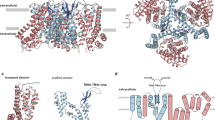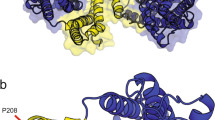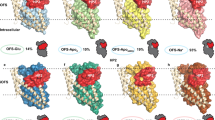Abstract
Episodic ataxia type 6 (EA6) is caused by mutations in SLC1A3 that encodes excitatory amino acid transporter 1 (EAAT1), a glial glutamate transporter. EAAT1 regulates the extent and durations of glutamate-mediated signal by the clearance of glutamate after synaptic release. In addition, EAAT1 also has an anion channel activity that prevents additional glutamate release. We identified a missense mutation in SLC1A3 in a family with EA. The proband exhibited typical EA2-like symptoms such as recurrent ataxia, slurred speech with a duration of several hours, interictal nystagmus and response to acetazolamide, but had late-onset age of sixth decade. Whole-exome sequencing detected a heterozygous c.1177G>A mutation in SLC1A3. This mutation predicted a substitution of isoleucine for a highly conserved valine residue in the seventh transmembrane domain of EAAT1. The mutation was not present in 100 controls, a large panel of in-house genome data and various mutation databases. Most functional prediction scores revealed to be deleterious. Same heterozygous mutation was identified in one clinically affected family member and two asymptomatic members. Our data expand the mutation spectrum of SLC1A3 and the clinical phenotype of EA6.
Similar content being viewed by others
Log in or create a free account to read this content
Gain free access to this article, as well as selected content from this journal and more on nature.com
or
References
Jen, J. C., Graves, T. D., Hess, E. J., Hanna, M. G., Griggs, R. C., Baloh, R. W. et al. Primary episodic ataxias: diagnosis, pathogenesis and treatment. Brain 130, 2484–2493 (2007).
de Vries, B., Mamsa, H., Stam, A. H., Wan, J., Bakker, S. L., Vanmolkot, K. R. et al. Episodic ataxia associated with EAAT1 mutation C186S affecting glutamate reuptake. Arch. Neurol. 66, 97–101 (2009).
Jen, J. C., Wan, J., Palos, T. P., Howard, B. D. & Baloh, R. W. Mutation in the glutamate transporter EAAT1 causes episodic ataxia, hemiplegia, and seizures. Neurology 65, 529–534 (2005).
Banner, S. J., Fray, A. E., Ince, P. G., Steward, M., Cookson, M. R. & Shaw, P. J. The expression of the glutamate re-uptake transporter excitatory amino acid transporter 1 (EAAT1) in the normal human CNS and in motor neurone disease: an immunohistochemical study. Neuroscience 109, 27–44 (2002).
Jiang, J. & Amara, S. G. New views of glutamate transporter structure and function: advances and challenges. Neuropharmacology 60, 172–181 (2011).
Fairman, W. A., Vandenberg, R. J., Arriza, J. L., Kavanaugh, M. P. & Amara, S. G. An excitatory amino-acid transporter with properties of a ligand-gated chloride channel. Nature 375, 599–603 (1995).
Winter, N., Kovermann, P. & Fahlke, C. A point mutation associated with episodic ataxia 6 increases glutamate transporter anion currents. Brain 135, 3416–3425 (2012).
Seal, R. P. & Amara, S. G. A reentrant loop domain in the glutamate carrier EAAT1 participates in substrate binding and translocation. Neuron 21, 1487–1498 (1998).
Yernool, D., Boudker, O., Jin, Y. & Gouaux, E. Structure of a glutamate transporter homologue from Pyrococcus horikoshii. Nature 431, 811–818 (2004).
Amara, S. G. & Fontana, A. C. Excitatory amino acid transporters: keeping up with glutamate. Neurochem. Int. 41, 313–318 (2002).
Kanner, B. I. & Borre, L. The dual-function glutamate transporters: structure and molecular characterisation of the substrate-binding sites. Biochem. Biophys. Acta. 1555, 92–95 (2002).
Huang, S. & Vandenberg, R. J. Mutations in transmembrane domains 5 and 7 of the human excitatory amino acid transporter 1 affect the substrate-activated anion channel. Biochemistry 46, 9685–9692 (2007).
Ryan, R. M., Mitrovic, A. D. & Vandenberg, R. J. The chloride permeation pathway of a glutamate transporter and its proximity to the glutamate translocation pathway. J. Biol. Chem. 279, 20742–20751 (2004).
Grunewald, M. & Kanner, B. I. The accessibility of a novel reentrant loop of the glutamate transporter GLT-1 is restricted by its substrate. J. Biol. Chem. 275, 9684–9689 (2000).
Pyle, A., Smertenko, T., Bargiela, D., Griffin, H., Duff, J., Appleton, M. et al. Exome sequencing in undiagnosed inherited and sporadic ataxias. Brain 138, 276–283 (2015).
Cuenca-León, E., Banchs, I., Serra, S. A., Latorre, P., Fernàndez-Castillo, N. & Corominas, R. Late-onset episodic ataxia type 2 associated with a novel loss-of-function mutation in the CACNA1A gene. J. Neurol. Sci. 280, 10–14 (2009).
Imbrici, P., Eunson, L. H., Graves, T. D., Bhatia, K. P., Wadia, N. H. & Kullmann, D. M. Late-onset episodic ataxia type 2 due to an in-frame insertion in CACNA1A. Neurology 65, 944–946 (2005).
Choi, K. D., Yook, J. W., Kim, M. J., Kim, H. S., Park, Y. E., Kim, J. S. et al. Possible anticipation associated with a novel splice site mutation in episodic ataxia type 2. Neurol. Sci. 34, 1629–1632 (2013).
Damji, K. F., Allingham, R. R., Pollock, S. C., Small, K., Lewis, K. E. & Stajich, J. M. Periodic vestibulocerebellar ataxia, an autosomal dominant ataxia with defective smooth pursuit, is genetically distinct from other autosomal dominant ataxias. Arch. Neurol. 53, 338–344 (1996).
Escayg, A., De Waard, M., Lee, D. D., Bichet, D., Wolf, P. & Mayer, T. Coding and noncoding variation of the human calcium-channel beta4-subunit gene CACNB4 in patients with idiopathic generalized epilepsy and episodic ataxia. Am. J. Hum. Genet. 66, 1531–1539 (2000).
Watase, K., Hashimoto, K., Kano, M., Yamada, K., Watanabe, M. & Inoue, Y. Motor discoordination and increased susceptibility to cerebellar injury in GLAST mutant mice. Eur. J. Neurosci. 10, 976–988 (1998).
Acknowledgements
This research was supported by Basic Science Research Program through the National Research Foundation of Korea funded by the Ministry of Education (NRF-2015R1D1A1A01060559).
Author information
Authors and Affiliations
Corresponding author
Ethics declarations
Competing interests
The authors declare no conflict of interest.
Additional information
Supplementary Information accompanies the paper on Journal of Human Genetics website
Supplementary information
Rights and permissions
About this article
Cite this article
Choi, KD., Jen, J., Choi, S. et al. Late-onset episodic ataxia associated with SLC1A3 mutation. J Hum Genet 62, 443–446 (2017). https://doi.org/10.1038/jhg.2016.137
Received:
Revised:
Accepted:
Published:
Issue date:
DOI: https://doi.org/10.1038/jhg.2016.137
This article is cited by
-
Late-onset vestibulocerebellar ataxia: clinical and genetic studies in a long follow-up series of 50 patients
Journal of Neurology (2025)
-
Progress in Structural Biology of Solute Carriers
Current Molecular Biology Reports (2021)
-
A novel mutation in SLC1A3 causes episodic ataxia
Journal of Human Genetics (2018)
-
Draft de novo transcriptome assembly and proteome characterization of the electric lobe of Tetronarce californica: a molecular tool for the study of cholinergic neurotransmission in the electric organ
BMC Genomics (2017)
-
Genetic Variants Associated with Episodic Ataxia in Korea
Scientific Reports (2017)



